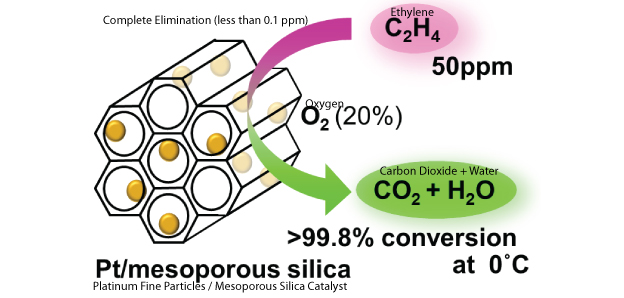Hokkaido University Technology Used in Refrigerator by Hitachi Appliances
Research Press Release | July 29, 2015

| Press Release | ||
|---|---|---|
| Key Points | ・A new platinum catalyst that was developed by Professor Atsushi Fukuoka of the Catalysis Research Center of Hokkaido University will be used in the 2015 model of Hitachi Appliances, Inc., new home refrigerator marketed to go on sale this summer.
・The new platinum catalyst is mounted in the vegetable compartment of the new refrigerator, and it is expected that it will greatly improve the ability to maintain vegetable freshness. |
|
| Overview |
Ethylene gas released by vegetables can spoil their freshness. Platinum catalyst1 technology which is supported on nano-space material such as mesoporous silica—that has the ability to decompose the ethylene gas and convert it into carbon dioxide gas—will delay spoilage by making vegetables dormant so they preserve their freshness. Hokkaido University issued a press release2 on platinum catalysts in the spring of 2013, and this resulted in joint research with Hitachi Appliances, Inc.. Prior platinum catalysts did not exhibit activity unless the temperature was high, which hindered use in refrigeration, but the new platinum catalyst technology which was developed through joint research has the ability to efficiently decompose ethylene gas into carbon dioxide gas even in the low-temperature environment of a refrigerator. Compared to previous methods such as photocatalysis, the new platinum catalyst technology can efficiently generate carbon dioxide gas which effectively puts vegetables into a dormant-like state which reinforces the refrigerator’s capabilities to maintain vegetable freshness. Freshness maintenance technology for vegetables, fruits, and flowers is drawing great attention in industries that have a strong incentive to carry fresh goods a long distance such as the distribution industry, and the Catalysis Research Center is planning to build on their current technology to further advance the development of high-efficiency, high-performance catalyst technology. 1 Platinum Catalyst: A catalyst in which platinum nano-particles are supported within the regularly spaced pores of mesoporous silica. Even under the low-temperature conditions of 0°C the platinum catalyst can oxidatively decompose ethylene gas to generate carbon dioxide. In 2006-2007, Hokkaido University and Taiyo Kagaku Co., Ltd. developed platinum catalyst technology through joint research on the “Practical Development of Platinum Catalysts Supported on Mesoporous Silica” under “Development of High-Function Hybrid Catalyst Technology Using Regularly Spaced Nano-Pores” of the Energy-Saving Chemical Technology Creation Research Project of the Ministry of Economy, Trade, and Industry. 2 On May 21, 2013, Hokkaido University and Taiyo Kagaku Co., Ltd. jointly announced success in developing a catalyst to eliminate, at low temperature, small amounts of ethylene that causes the decay of fruits, vegetables, and flowers. |
|
|
Atsushi FUKUOKA, Professor, Fukuoka Lab, Catalysis Research Center, Hokkaido University TEL: +81-11-706-9140 FAX: +81-11-706-9139 E-mail: fukuoka@cat.hokudai.ac.jp |
||
|
Japanese Link |
北海道大学が開発した新プラチナ触媒が日立アプライアンスの新型家庭用冷蔵庫に搭載 (2015.7.17) | |
